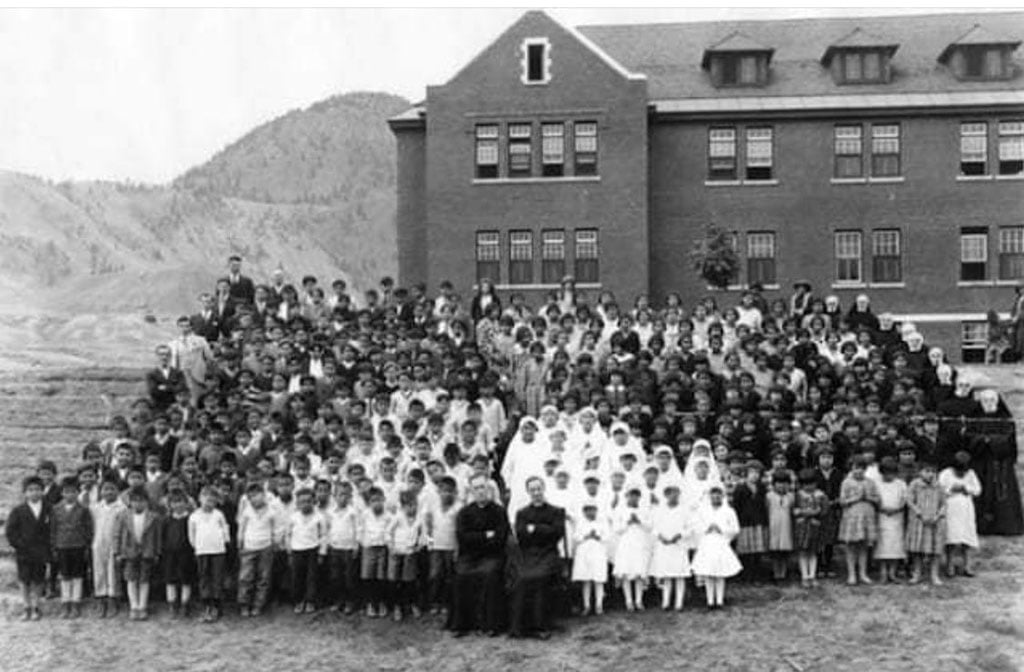On July 6, 1885, Sir John A. Macdonald rose in Parliament to reaffirm the by then well-established colonial portrait of Indigenous peoples as a danger to society and spreaders of illness. “I have not hesitated to tell this House, again and again, that we could not always hope to maintain peace with the Indians; that the savage was still a savage, and that until he ceased to be savage, we were always in danger of a collision, in danger of war, in danger of an outbreak,” he said.
The quote is included in Bob Joseph’s book 21 Things You May Not Know About the Indian Act, an excellent primer on the cruel and racist legislation that continues to oppress First Nations.
If Joseph had wanted to make it 22 things, he could have added that the Indian Act was the result of words not just by politicians but also Canada’s press, each feeding the other in a vicious circle of denigrating stereotypes and justifications for genocidal policies.
The Indian Act, created in 1876, didn’t just appear out of nowhere. Like most legislation, it had to have been the product of research, documentation, consultation and public support. The news media of the day, therefore, played an instrumental role in rallying the citizenry and providing politicians their talking points.
Shocking headlines portraying First Nations as savage threats regularly appeared in journals and missionary newspapers at the time. These also proved useful for creating, in 1868, the Dominion Police, who joined with the North West Mounted Police before they became the RCMP. Today, the RCMP claim they were formed to guard Parliament and protect First Nations peoples.
But scholars say the force was created mainly to enforce the Indian Act. The purpose of the Mounties “effectively, was to clear the plains, the Prairies, of Indigenous people,” says Steve Hewitt, who teaches at the University of Birmingham and has written three books about the RCMP’s history. “Ultimately, they were there to displace Indigenous people, to move them onto reserves whether they were willing to go or not.”
In the years leading up to the making of the Indian Act and the Dominion Police, publications in Canada, too many to count, were publishing stories promising tales of “Indian Atrocities” and white settlers held “Indian Captive.” The effect was to scare white readership into believing that Indigenous peoples were a mortal threat. And sow the need for a law that would govern and control Indigenous peoples.
Mark Cronlund Anderson, author of Seeing Red: A History of Natives in Canadian Newspapers, explains that Canadians were taught by their media that Indigenous people were lesser humans. “In this way,” he writes, “the press has both reflected naturally and regurgitated spontaneously and necessarily the culture from which it emerged at the same time as reinforcing and teaching prevailing social norms to youth and newcomer.”
Anderson talks about the rule of three. The news portrayed Indigenous peoples as having a trio of all-encompassing negative qualities: depravity, innate inferiority and a stubborn resistance to progress. The rule of three is “the reasoning that engendered the creation of the treaty system and residential schools.”
And once the residential schools existed, the news media assisted in downplaying their harsh realities. Take, for example, a news article with the headline “Indian Boy Frozen on Bush Trail” published by the Regina Leader Post newspaper in 1938 and cited in the Truth and Reconciliation Commission’s report “Canada’s Residential Schools: Missing Children and Unmarked Burials.” The reader is told that an 11-year-old boy named Andrew Gordon “left the school Saturday afternoon to visit his parents and had trudged, thinly-clad, more than four miles through dense woods and snow from three to five feet deep.” The article implies that the boy had simply gone out for a walk and left no indication that he may have fled the school out of misery or fear for his life.
The story stated that Gordon was the grandson of the “oldest Indian chief in Canada.” Which leaves hanging the question: Would this child’s untimely death have made the news if he hadn’t been the grandson of a prominent Chief? Most likely not, as we have been reminded by the recent discovery of bodies of children on the grounds of a residential school in Kamloops. The deaths of all 215 children apparently went undocumented by the media in a timespan of 128 years since the school opened in 1893.
Candis Callison is a member of the Tahltan Nation and an associate professor at the University of British Columbia in the Institute for Critical Indigenous Studies and the School of Journalism, Writing and Media. An expert in the power and role of media, Callison notes that Canada’s settler society was complacent about the harms caused by the residential school system for nearly a century. “Why weren’t media of the day asking questions about the welfare and well-being of children?” she says. “Why weren’t media asking why the church was still in control of these schools well into the 20th century and towards the end of it? It is not that long ago that many of these incidents happened.”
Dominant society continues to portray Indigenous peoples as dangerous, though nowadays the risk is more commonly framed by mainstream media using what Callison calls a “deficit model.” That framing assumes that it’s OK to control Indigenous peoples by deeming them unable to take care of themselves, their land and their children, explains Callison. Such mythology about Indigenous inferiority is deeply rooted in national identity. Callison calls it “part of the founding of Canada.”
Canada’s founding leaders and their supportive news media shared the goal of achieving assimilation — ensuring that Indigenous peoples were incorporated into the dominant group’s way of life. Residential schools were key tools for attempting to erase Indigenous cultural and spiritual beliefs and have Indigenous peoples fall in line with more organized religious belief systems.
A century and a half after the Indian Act was made law, as deadly truths about the Kamloops residential school became impossible to ignore, those institutions who had a part in hiding the truth — the church, the police, the government and the news media — had no part in helping to uncover the grave sites. The need to do so certainly had been made known. The Truth and Reconciliation Commission had concluded there were thousands of undocumented graves of children on residential school grounds and sought a mere $1.5 million to find them — a request rejected by the administrator of the Indian Act, Canada’s federal government.
And so members of the Tk’emlúps te Secwépemc Nation were the ones who had to do the work of finding their kin and putting out a press release. Only then did dozens of reporters flood the area to get their big breaking story without pausing to first consider the grief that was felt in the community. Most of the news media moved on quickly to their next big headlines in a blink of an eye, while reporters like Kelsie Kilawna with IndigiNews Kelowna stay with this story, stepping up to tell reporters to be sensitive when reporting on issues that are too close to home for many.
By the time Canada’s “founding father” delivered his views on Indigenous “savages” quoted at the top of this piece, the Indian Act was nine years in place. But key steps leading up to it had been officially laid 55 years earlier.
Launched in 1830, the Indian Civilization program was based on three philosophical principles, states historian John F. Leslie in testimony given to Parliament in 2002. These were: Indian protection, based on the Royal Proclamation; improvement of Indian living conditions; and Indian assimilation into the dominant society.
“Between 1830 and 1858, there were six government investigations of Indian policy and the new administrative arrangements,” writes Leslie. “The cumulative investigations sanctioned the Indian civilization program and, in essence, created an institutional memory for Indian Affairs policy-makers that, in subsequent decades, informed their attitudes towards Indian people and Indian issues.” These so-called investigations sought virtually no Indigenous participation and were fictional scenarios written by those with the power to publish.
When discussing Indigenous issues in the late 19th century, writes University of the Fraser Valley professor Robert Harding in a 2006 journal article, "a wide range of oppositions were employed in news texts, beginning with the most basic ones, such as us vs. them and civilized vs. savage." To this day much reporting situates Indigenous people as problematic and not credible, pitting the voices of Indigenous peoples against those of government experts and offices. The government response is taken as the patriarchal final say invested with the power to make decisions for Indigenous peoples.
It’s a very old assumption, long reinforced by the media. Harding notes that as a white settler Canada came into being, journalists transmitting the most negative stereotypes about Indigenous peoples generally believed they were helping to save rather than destroy the subjects of their articles. He offers as an example the newspaper of the Metlakahtlan Christian mission, which in the late 1800s extolled the heroic qualities of white men and demonized the customs, practices and beliefs of Indigenous people. Concludes Harding: “The idea that Canadians of Aboriginal ancestry epitomize moral depravity is as old as the press in Canada.”
Callison points to skewed coverage of the 2019 release of the Missing and Murdered Indigenous Women and Girls report to illustrate how powerful mainstream media is still implying Indigenous inferiority. The lengthy report well documents the genocidal nature of Canada’s policies toward Indigenous peoples, providing much expert analysis. Yet as Callison explains, every major newspaper in Canada issued editorials that challenged the authors’ use of the word genocide. The result was to undercut the credibility of the report instead of actually drawing from it as a tool for accountability.
One reason Canada’s news media remains condescending towards Indigenous persons is that newsrooms include so few of them, notes Callison, who dissects such structural inequalities as co-author of the book Reckoning: Journalism’s Limits and Possibilities. She says, “When in a hierarchical society you end up with a certain kind of coverage. When you have newsrooms with dominant members of society you have stories that reflect that.”
And those newsrooms, decade after decade, told the same stories John A. Macdonald told Parliament. Back in the 1860s, writes Harding, “while Aboriginal people definitely took an interest in what was being written about them and frequently attempted to set the record straight, their voices were virtually excluded from news discourse. Aboriginal sources were not quoted and news stories were exclusively targeted to non-aboriginal audiences." Even nowadays, as veteran CBC journalist and professor of journalism Duncan McCue, who is Anishinaabe, puts it, for an Indigenous person to make the news they either need to be “drunk, drumming, dancing or dead.”
McCue and Callison are part of an important movement in education to create awareness of how Canada's press historically has served to help build and support institutions that degrade, denigrate and marginalize Indigenous peoples. The aim of such teaching is to change the way Canada’s news media operates. “Journalism provides us with a set of tools and how we use those tools can move us towards justice, can move us away from suffering,” notes Callison.
If Canada’s news media helped to bring to life the Indian Act, it can also help to dismantle it by shining a light on the truth behind the veil of colonialism. ![]()
Read more: Indigenous, Rights + Justice, Media

















Tyee Commenting Guidelines
Comments that violate guidelines risk being deleted, and violations may result in a temporary or permanent user ban. Maintain the spirit of good conversation to stay in the discussion and be patient with moderators. Comments are reviewed regularly but not in real time.
Do:
Do not: